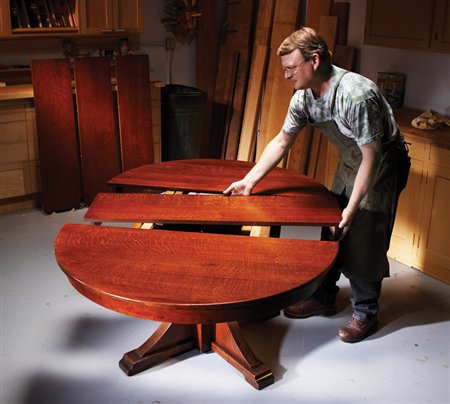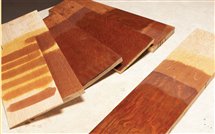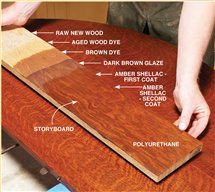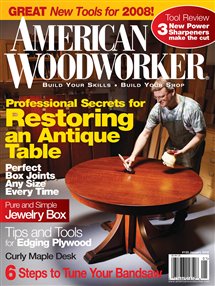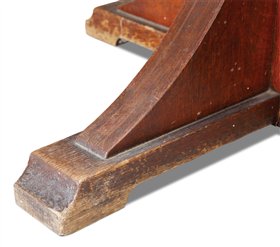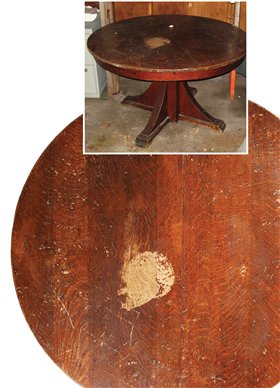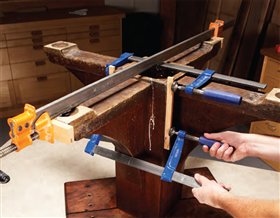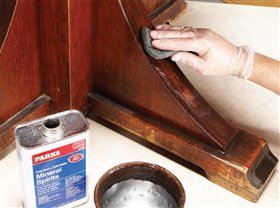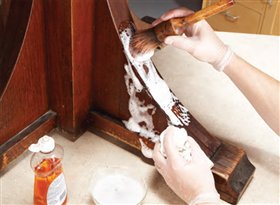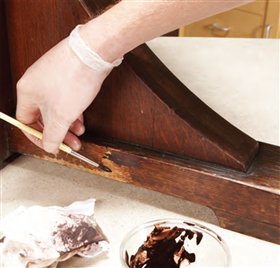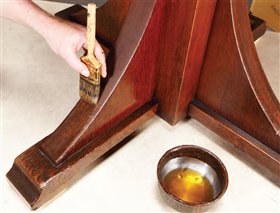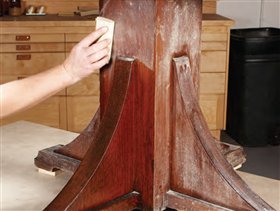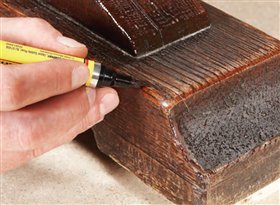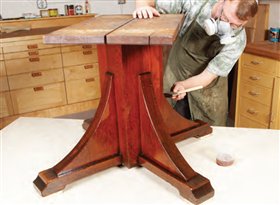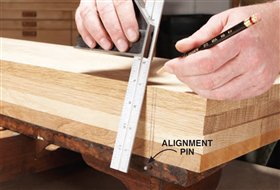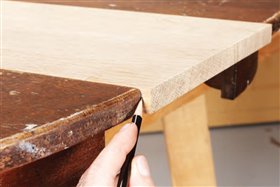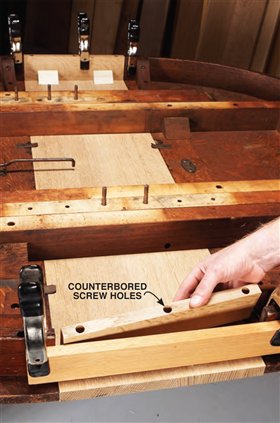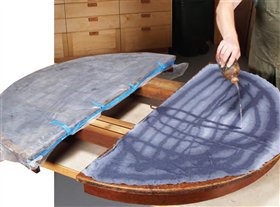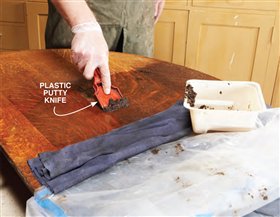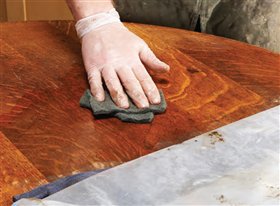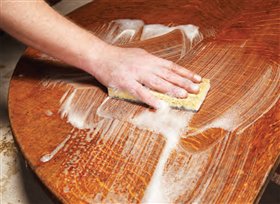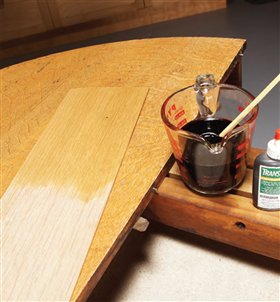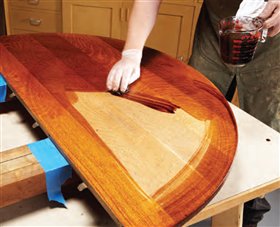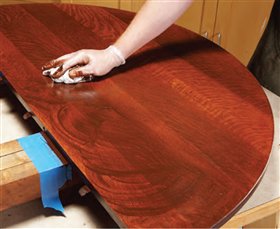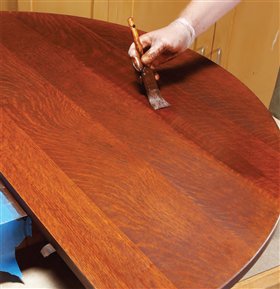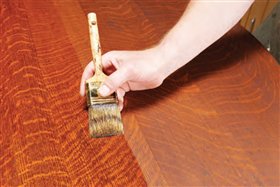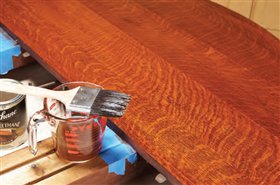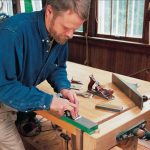|
This old table looks like a prime candidate
for refinishing. Strip off the old
finish, sand out all the dings and
scratches, spray on a catalyzed
lacquer finish and it would
look brand new. But in
my opinion, doing this
would rob the table of
its history. Lovers of
antique furniture value
an original finish in part
because of the witness it bears. In
its present condition this table does that – it tells
a story 100 years old. But let’s face it. As it is, the
table is an eyesore.
That’s the conundrum of working with antique
furniture. In some cases, the original finish adds
real historic, aesthetic, and monetary value. But
in pieces like this, saving all of the original finish
makes no sense; the poor condition of
the top’s finish is actually a detriment.
Sentencing these pieces to the stripper’s
tank, the first step in most
refinishing today, isn’t always the
best approach, either. I believe
that most owners of antique furniture
want to be good stewards
of their pieces, which includes
maintaining the furniture for
future generations. Sometimes
that means preserving the original
finish; sometimes it means
refinishing. In the case of this
old table, it means a little of both.
Devise a plan
My goal is to retain as much of this table’s original
condition as possible, while restoring its viability for
everyday use. To plan the restoration, I have to analyze
the table’s current condition. The first step is to determine
the nature of the original finish. Simple tests
show that it dissolves quickly in alcohol and contains
most of the color. Based on these qualities and the
table’s age, my educated guess is that the original finish
is tinted shellac.
Next, I want to find examples of the original finish
that are still in good condition. Protected areas are the
best place to look. On this table, the pedestal’s original
finish is dirty and oxidized, but it’s 90-percent intact
and definitely restorable (top photo). The same
is true of the finish on the top’s apron.
The top itself, on the other hand, poses numerous
challenges (second photo from top). Its
original finish is beyond repair, and unfortunately,
I’ve determined that most of the original color will
be lost when the finish is removed. Areas on the top
where the finish has been long-gone are likely to be
discolored. On the other hand, the wood surface contains
character marks from 100 years of use that I want
to save: pockmarks, nicks and scratches will help the
new finish look authentic. And not surprisingly, the
original leaves are missing.
Here’s my restoration plan. First, I’ll bring back the
rich color and depth of the pedestal’s original tinted
shellac finish. Then I’ll use its restored appearance to
guide my work on the top.
By working gently and carefully while I remove the
top’s deteriorated finish, I’ll leave as much of the old
patina and original wood surface as I can. I’ll treat the
top chemically, if necessary, to minimize discoloration.
I’ll build new leaves using quartersawn white oak, the
same species of wood as the top, so they’ll have similar
figure and texture. Then I’ll create a new finish that will
match the restored finish on the pedestal. This new finish
will have greater resistance to heat and water than
the original shellac finish, so it will stand up to daily use
for years to come. I’ll tweak the color of this finish to
make the new leaves match the 100-year-old top.
Restore the pedestal
The pedestal requires minor repair (Photo 1). I usually
complete repairs before I restore a finish. Cleaning the
old finish is a two-step process (Photos 2 and 3). Next,
replace the missing color with glaze (Photo 4). Make your
own glaze by mixing artists oil color in glazing medium (see “Recipes,” below). When the glaze is thoroughly
dry, rejuvenate the old shellac by brushing on two coats of
fresh dewaxed shellac (Photo 5 and Sources, below). Wait
45 minutes between coats; sanding isn’t necessary. Let the
second coat dry thoroughly. Then sand lightly (Photo 6).
Remove all the sanding dust and touch up spots of missing
finish or sand-though with a touch-up pen (Photo 7 and
Sources, below). Use the same procedure to restore the
finish on the apron.
The final step, topcoating with polyurethane, is optional
(Photo 8). For purists, polyurethane compromises the
original finish. For others, it helps to make the pedestal’s
appearance match the top.
Build the leaves
This table expands to 96 inches, allowing the addition
of four 12-in.-wide leaves. The new leaves must be the
same thickness as the top after they’ve been finish-sanded.
The best strategy is to glue the leaves together about
1/8-in. oversize in thickness and at least one inch oversize
in length (Photo 9). Plane them again after gluing, allowing
enough material to sand them to final thickness.
To fit in the table, the leaves’ pins and holes must
align with the original ones in the top (Photo 10).
Determine the original pins’ vertical location on the
edge; usually they’re centered between the top and
bottom faces. Drill the pin holes in the leaves, using a
doweling jig, and install the pins (see Sources, below).
Cut the leaves to final length (Photo 11). Install the leaf
aprons after drilling counterbored holes for the mounting
screws (Photo 12). Center each apron on the leaf;
the aprons are 1/16-in. shorter than the leaf’s width, to
allow seasonal movement without binding.
Remove the top’s old finish
Because the old finish is shellac, I can use a simple
technique that minimizes the use of solvents (Photo 13).
It also preserves as much of the original patina and character
as possible. Cut an old cotton sheet to fit the top.
Position each piece and then saturate them with alcohol,
using a small squirt bottle to distribute the alcohol evenly
(alcohol has low toxicity, but it is highly flammable, so be
careful). Use only enough alcohol to wet the cloth. Excess
alcohol just makes a mess—adding more later is always an
option. Cover the saturated cloth with plastic to keep the
alcohol from evaporating.
After about fifteen minutes, peel back one end of the
plastic and cloth. You should see liquefied shellac (if you
don’t, just re-cover the surface and wait a bit longer). The
trick here is to expose about 12-in. of the top at a time.
Begin removing finish with a plastic putty knife (Photo
14). The only residue from this process is the old shellac,
which is non-toxic. When most of the finish is gone, gently
scrub with a nylon pad dampened in alcohol (Photo 15).
Unlike steel wool, nylon pads don’t leave behind tiny bits
of steel (they can cause black marks on the wood). Squirt
on more alcohol as needed. Then rinse with a clean
cloth and alcohol. When the first area is clean, peel back
another 12-in. or so and continue.
After you’ve completed half of the table, examine the
surface under good light and wash with alcohol as needed.
Then give it a final overall rinse and scrub with alcohol
and clean rags—this should produce a very consistent
surface. Repeat the process on the other half of the top.
Wash both halves of the top with mild dish soap and
water (Photo 16). The surfaces should be consistently
porous. Spots where water “beads up” instead of soaking
may indicate residual finish, as may spots where the surface
remains light-colored. When the top is evenly porous,
rinse it off and let it dry.
Decide about sanding
Examine the surfaces to determine if sanding is
necessary. Many pieces need little or none at all.
Whether or not you sand depends on your restoration
goals. Sanding may remove grayed areas and
other unsightly marks. But sanding may also eliminate
character marks you want to save. The danger
is that sanding a little can lead to sanding a lot.
Focusing on an imperfection can cause a problem
area to become larger.
This top showed several grayed spots where finish
had been missing, so I decided to try removing
them with light sanding. I used 180-grit paper on a
felt block to minimize the effect on the character
marks. The results were a wash—neither the character
marks nor the gray spots disappeared.
When grayish discolorations persist, I use oxalic
acid. Oxalic acid is bleach that only changes the
color of oxidized (grayed or blackened) wood (see
“Dealing with Discoloration,” below).
Match new wood to old
Matching the new leaves to the old top requires
only one step: adding color. As white oak ages, it
acquires warm yellow and tan tones (“golden oak”
wood stains are usually variations of this color).
Water-soluble dye is the best choice for this step. It
colors more uniformly than stain and doesn’t seal
the wood. Using a test board, mix dye to match the
color of the top (Photo 17 and “Recipes,” below).
Then dye all the leaves to give them that “golden
oak” glow. Every color-matching situation is different,
of course, so you may need to adjust my
recipe or create your own. You may even have to use
different-colored dyes.
Create the new finish
I used a multi-step process to create a new finish
that matches the appearance of the pedestal’s
restored finish. By adding color gradually, this process
provides maximum flexibility and control, so I
could zero in on an accurate color match. I made
test boards for every step and compared the color of
each step with the pedestal, to make sure I stayed on
track (see “Test Boards Record the Finish”, below).
As the dyed leaves have the same golden-tan color as
the top, they can be finished at the same time.
A close look at the pedestal’s deep, rich color
reveals varying shades of dark tones. To give the top
and leaves the same appearance, the color must be
applied in layers. First, dye the surfaces to match the
lightest shade of the pedestal’s dark color (Photo
18). Then apply a dark brown glaze mixed to match
the darker shades (Photo19). Make your own glaze by mixing artists oil color in glazing medium (see
Sources, below). If some boards appear lighter in
color, apply a second coat of glaze (Photo 20). The
final coloring step, two coats of amber shellac (2-lb.
cut), adds tone that’s essential to re-creating the
aged look and color (Photo 21).
The final steps are the same as on the pedestal.
First, apply one coat of dewaxed shellac to assure
that the polyurethane topcoats adhere. Sand this
surface with 400 grit paper by hand, using a soft
block. Next, apply two coats of oil-based satin polyurethane
(Photo 22). Sand with 400 grit between
coats. When the finish is thoroughly dry, gently rub
with the surface with #0000 steel wool and soapy
water to remove dust nibs. Now the table is ready for
another 100 years!
Recipes
Touch-up glaze for the pedestal’s
original dark color.
Mix burnt umber, Vandyke brown and ivoryblack
artists oil colors in glaze medium.
Sand-through Colors.
Sharpie touch-up markers for medium and
dark woods.
Ground color for leaves.
TransTint dye concentrate: 30 drops golden
brown dissolved in 3/4-cup water.
Medium-brown tones for top and leaves.
TransTint dye concentrate: 50 drops dark walnut,
50 drops dark mission brown and 80 drops
red mahogany dissolved in 3/4-cup water.
Dark-brown tones for top and leaves.
Mix burnt umber, burnt sienna and ivory black
artists oil color in glaze medium.
Dealing with discoloration

Areas where an original
finish has been completely
lost (Photo A) can
show significant discoloration
after the remaining
finish is removed (Photo
B). Minimizing this
discoloration requires
additional steps. Brush
the top with a solution
of oxalic acid (Photo
C) to remove the gray
color that resulted from
the unfinished area’s
long-term exposure to
air and water. The effect
is often almost immediately
noticable, while the
surface is still damp. This
treatment also removes
unsightly black water
spots from the rest of
the top.
Oxalic acid crystals are
available at hardware
and paint stores. Mix
one ounce of crystals
in a pint of hot water.
Brush the solution on
the surface and let it dry.
If necessary, apply the
solution a second time.
Rinse the surface thoroughly
with a solution of
vinegar and water and
let it dry. Oxalic acid is
poisonous, so don’t sniff
the crytals and wear
gloves when you apply
the solution and when
you rinse.
If the discoloration
has not completely
disappeared, blend it
in by applying dye that
matches the color of the
surrounding wood (Photo
D). Complete the job by
adding additional layers
of color, using dye and
glaze, (Photo E).
Test boards record the finish


The secret to matching the pedestal’s restored finish on both
the new leaves and the old top lies in creating test boards for
each step of the new finish. The test boards must be the same
wood as the leaves, so they match in appearance and quality.
They must also be prepped and sanded in exactly the same
way as the leaves.
Each test board should be large enough to allow both testing
and creating a reliable sample (one that clearly shows what
the finish will look like on a large surface). Conserve lumber by
resawing. For this table, I resawed a 5-ft. by 6-in.-wide board
(2-1/2-bd.ft.) to create 10 lineal feet of test boards.
The test boards are sequential, so each one tests only one
layer of finish. I always compare the color of each step with
the pedestal, to make sure I stay on track. I also create one
large “storyboard” for reference. It shows all the steps on the
front and has all the recipes marked on the back.
Sources
(Note: Product availability and costs are subject to change since original publication date.)
Woodcraft, woodcraft.com, 800-225-1153,
Economy Doweling Jig, #811564; Steel Table Pins, #27A30, need
16 pins for 4 leaves; TransTint Liquid Dye Concentrate: golden
brown, #128482, dark walnut, #128485, dark mission brown,
#128486, red mahogany, #828382; SealCoat (2-lb. cut liquid
dewaxed shellac), #823195; Amber Shellac (3-lb. cut), #140701.
*** Blick Art Materials, dickblick.com, 800-828-4548,
Round Sash Brush, #06342-1016, 42-mm-dia.; Windsor &
Newton Artists Oil Color, burnt umber, #00461-8053, Vandyke
brown, #00461-8313, burnt sienna, #00461-8043, ivory black,
#00461-2253, 37-ml. tube;
MisterArt.com, misterart.com, 800-721-3015,
Liquin Original Glazing Medium, 250 ml bottle, #64192; Sharpie
Wood Touch-Up Markers, pkg. of 3, light, medium and dark, #30499.
This story originally appeared in American Woodworker January 2008, issue #133.

January 2008, issue #133
Purchase this back issue.
|
|
Click any image to view a larger version.

The
pedestal’s
original shellac
finish is dirty and
has worn away in areas
near the floor. But overall, it’s
in good condition for its age and can
be restored without stripping.

The top’s original shellac finish is so heavily
worn and badly damaged that it can’t be
restored. The original leaves are missing, too,
so new ones have to be built. One challenge
is to replicate the pedestal’s restored finish.
Another challenge is to make new leaves that
match the old top.

1. The first step is to make repairs. Carefully protect the old
finish by removing glue squeeze-out promptly and gently,
using a dampened cloth. Here I’m gluing a crack in the
pedestal’s center post.

2. Gently clean the finish with steel wool and mineral spirits
to remove old furniture polish, wax and grease. The new
finish coats won’t adhere properly if these contaminants
remain on the surface.

3. Scrub the surface with mild dish soap to remove watersoluble
dirt and grime. A round sash brush (see Sources, below) is gentler than an abrasive pad and gets into corners
and crevices more effectively. Wipe frequently with a
cotton cloth so the surface doesn’t stay wet for long periods.

4. Color the areas of missing finish with glaze. Make your
own glaze by mixing artists oil color in glazing medium
(see Sources, page 10). Brush on the glaze and then wipe it
to blend with the existing finish.

5. Brush on two coats of fresh dewaxed shellac to rejuvenate
the original shellac finish and form a level coat
that’s thick enough to sand. This process restores the original
color and richness.

6. Sand with 400-grit paper to smooth the shellac. By
scuffing the surface, this step also prepares the pedestal
for the topcoat.

7. Color sand-throughs with a touch-up pen. The color
soaks into raw wood, but wipes off finished areas. Even
with careful sanding, sand-throughs are almost inevitable.

8. Apply two coats of satin polyurethane. This step is
optional, because the restored shellac finish is durable
enough for the pedestal. Polyurethane gives the pedestal a
sheen that will match the new finish planned for the top.

9. Building new leaves is the first step in restoring the top.
Glue the leaf blanks together, using boards similar in
width and figure to the boards on the tabletop.

10. Stack the leaf blanks on the table to locate the alignment
pins. Extend these marks across the top face of
each blank to locate the pin holes on the opposite edge.

11. Install each leaf blank in the top to mark it for cutting
to length.

12. Install the leaf aprons with the top upside down.
Clamp a board to the table aprons to ensure the
leaf apron is flush. Center the apron on the leaf, clamp it
in position and fasten it with screws and glue blocks.

13. Remove the top’s old finish. Cover the top with cloth
cut to fit, and saturate its surface with alcohol. Cover
the saturated cloth with plastic, tape the edges and let it sit
until the old finish has liquefied.

14. Fold back the covering in stages to remove the finish.
This method simultaneously divides the job into manageable
sections and keeps all of the old finish liquefied.

15. Remove the remaining shellac. Add more alcohol as
necessary, to keep the surface wet. A gray-colored
nylon abrasive pad won’t scratch the wood surface.

16. Gently scrub the stripped surface with mild dish soap
and water. This step removes water-soluble dirt and
crime that has lodged in areas where the finish has failed.

17. Use dye to tint the new oak leaves to match the
top’s aged color. Test the color on a sample
board made from the same lumber as the leaves.

18. Recreate the original dark color in stages. First,
apply brown-colored dye to give the top a medium-
brown tone. As the leaves now have the same aged
color as the top, you can use the same process on them.

19. Deepen the color with dark brown glaze applied
directly onto the dyed surface. Glaze is artists oil color
thinned for wiping. Brush the glaze on, then wipe it off.

20. Minimize color differences by applying a second coat
of glaze to light-colored boards after the first coat has
thoroughly dried.

21. Brush on a coat of amber dewaxed shellac. This step
is key to matching the top to the pedestal, because
the pedestal’s original finish coats are amber shellac.

22. Add durability by applying topcoats of polyurethane.
Polyurethane provides better resistance to heat and
moisture than shellac does.
|



